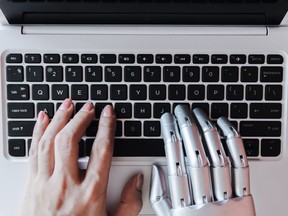Victoria Wells: Uptake is growing fast as workers see ‘unbelievable’ productivity gains, expert says

Article content
More employees in Canada are adopting artificial intelligence and reaping outsized gains in both the quality and quantity of their work, something experts say is merely the beginning in a massive shift in the way we work.
Article content
Article content
Almost a quarter of Canadians now use generative AI such as ChatGPT on the job, with more than 60 per cent using it over once a week, and one in five using it every day, according to a recent report by KPMG International Ltd. That represents a notable increase from just six months ago, when 20 per cent reported AI use at work, 52 per cent accessed it weekly and 18 per cent daily. KPMG’s Generative AI Adoption Index, which measures the uptake of the technology in workplaces, has grown 28 per cent since May and now sits at 14.6 out of 100. A score of 100 would indicate mass adoption, the firm said.
Advertisement 2
Article content
KPMG estimates uptake is growing by 32 per cent on a yearly basis, which could mean that 50 per cent of workers will be using AI on the job in Canada within three years. In other words, there’s no stuffing this cat back into the bag, “The user experience is so easy as an entry point that I think that’s really what’s driving (the growth),” Marc Low, a director at KPMG’s Ignition innovation lab, said. As people continue to see value in AI tools, their uptake is only expected to accelerate. “It’s going to get even more weird and wild and wonderful in the year ahead,” he said. “Not slowing down, for sure.”
Workers are using AI to do everything from conducting research and creating first drafts of documents or presentations to automating accounts payable processes and other repetitive tasks. As a result, they are getting more done and faster, with 58 per cent saying AI is saving them one to five hours a week. And 90 per cent say the quality of their work has improved. Productivity gains from incorporating AI have been “unbelievable,” Low said. “These tools are really helping employees just add capacity and the ability to think.”
Article content
Advertisement 3
Article content
Article content
Job hunters are also getting in on the gains, with more than 30 per cent using AI to help write resumés and cover letters and prepare for interviews so they can stand out from the crowd, according to research by recruiter Robert Half Inc. It’s been especially effective for networking on LinkedIn, the power of which many “underestimate,” said Mike Shekhtman, a senior regional director at the firm. “(AI is) a tool that helps automate and cut down on time spent, because … professionals are not resumé writers and they’re not professional writers.”
But using AI doesn’t come without risks. For one thing, results can be inaccurate or just plain wrong. “You’ve got to make sure you’re still doing your homework to double check,” Shekhtman said. That was highlighted in a recent case involving Donald Trump’s former lawyer Michael Cohen. In an attempt to end his client’s court supervision after a prison stint, Cohen’s attorney included three fake cases in an argument to the judge, an error experts said smacks of improper AI use.
There are also security risks when using a public AI program such as ChatGPT. Uploading information automatically makes it part of the public domain, risking the exposure of confidential internal data. As a result, some companies have created usage policies, or even banned AI altogether.
Advertisement 4
Article content
But others are working to develop internal AI tools so employees can capitalize on productivity gains. Low said KPMG has identified at least 600 different AI use cases that can be leveraged across organizations. It’s also something workers are clamouring for, he said. “They want access to tools, they want training, they want to understand how they work. Employers are trying to figure out how to facilitate that in a safe way.”
Of course, not every employee is eager to include AI in their workflows, with the level of unease often falling along generational lines. For example, gen-Zers and millennials are much more optimistic about generative AI compared to gen-Xers and baby boomers, separate Robert Half research shows. But there’s a risk in that reluctance to embrace new tools, Shekhtman said. “The train has left,” he said. “If you’re not going to get on board, you’re going to get run over by it.”
Recommended from Editorial
-

AI coming to an office job near you? Bring it on, workers say
-

Rosenberg: White-collar jobs will be painful casualty of AI
-

Employers are racing to catch up as workers experiment with AI
-

Are employees really working or are they delegating to ChatGPT?
Advertisement 5
Article content
Fears that AI will eliminate wide swaths of jobs, especially white-collar ones, could be contributing to some people’s hesitancy to embrace it. Automation could disrupt more than 300 million jobs across the United States and Europe, research from Goldman Sachs Group Inc. indicates. But that doesn’t necessarily mean AI will put everyone out of work. Experts believe positions will likely be reimagined as the tools help workers do more. “It’s not a replacing of a job; it’s more an enhancement of a job,” Shekhtman said.
AI also creates the potential for a tidal wave of new job creation, the likes of which we don’t yet understand, Low said. “We can’t even comprehend or imagine yet the jobs that are going to come out of this,” he said. “There’s going to be entirely new skill sets, new functions that will be birthed into the world as a result of these technologies.”
• Email: vwells@postmedia.com
A version of this story was first published in the FP Work newsletter, a curated look at the changing world of work. Sign up to receive it in your inbox every Tuesday.
Bookmark our website and support our journalism: Don’t miss the business news you need to know — add financialpost.com to your bookmarks and sign up for our newsletters here.
Article content
AI use at work skyrocketing and it’s just the start of a massive shift
2023-12-19 14:38:03









